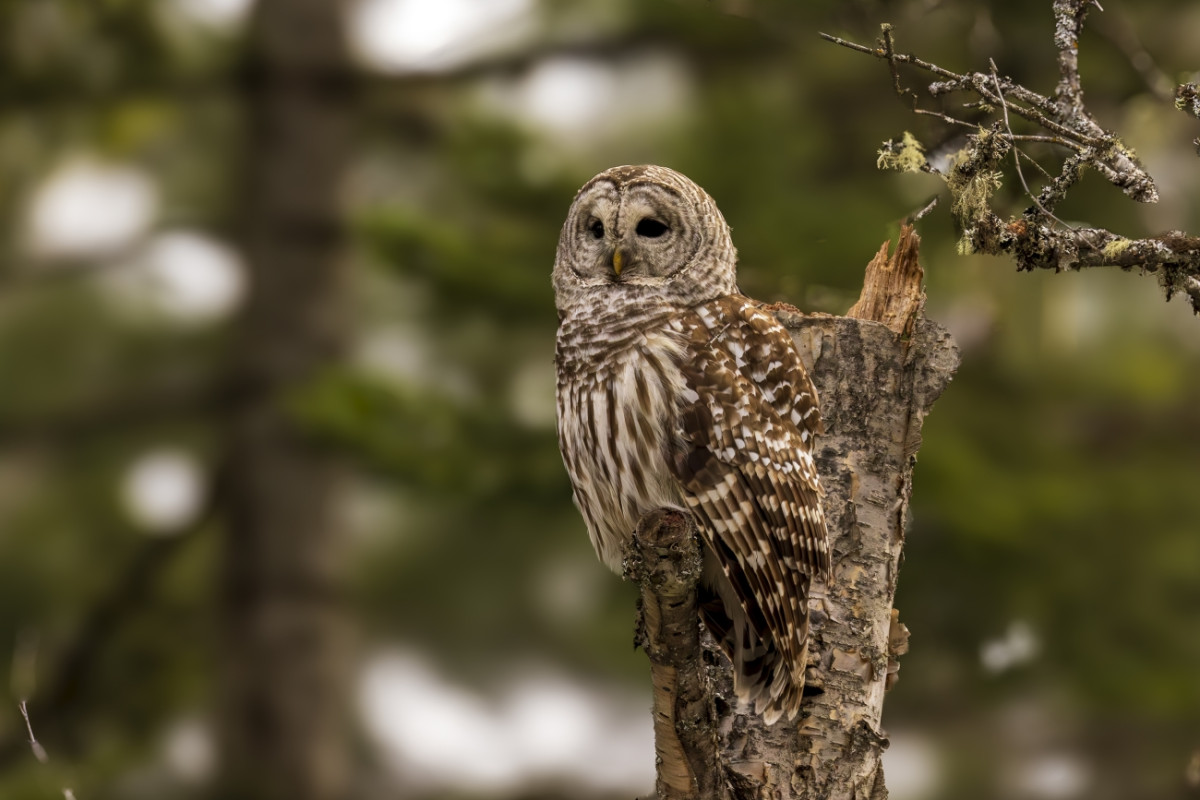The barred owl’s westward migration threatens other species and a whole ecosystem, UW researchers find – University of Wisconsin–Madison

Report on the Ecological Impact of Invasive Barred Owls and Implications for Sustainable Development Goals
Introduction: An Invasive Predator Threatening Biodiversity
A recent study led by the University of Wisconsin–Madison details the significant ecological threat posed by the invasive barred owl (Strix varia) on the U.S. West Coast. Analysis of nearly 800 individuals reveals a broad diet that includes numerous species with protected status. This invasion, facilitated by human-induced environmental changes, presents a direct challenge to the achievement of the United Nations Sustainable Development Goals (SDGs), particularly SDG 15 (Life on Land), which aims to halt biodiversity loss.
Key Findings and Direct Relevance to SDG 15 (Life on Land)
The research provides critical data demonstrating the barred owl’s impact on native fauna, undermining progress toward SDG Target 15.5, which calls for urgent action to protect threatened species and prevent their extinction. The study’s primary findings include:
- A total of 162 distinct prey species were identified in the owls’ diet through DNA analysis.
- Of these, 29 species hold special conservation status under federal or state regulations.
- The affected species span a wide range of taxa, indicating a systemic, ecosystem-level threat. This includes mammals, birds, fish, amphibians, and reptiles.
Analysis of Affected Species and Broader SDG Implications
The barred owl’s generalist predatory behavior creates cascading effects on the food web, impacting multiple SDGs.
- Threats to Native Predators: The barred owl preys on and outcompetes native species, including the threatened northern and California spotted owls. It also consumes other predators like the western screech owl and the ringtail, compounding pressure on these populations and disrupting the ecological balance essential for achieving SDG 15.
- Impact on Aquatic Ecosystems (SDG 14): The detection of federally threatened coho salmon in the owls’ diet demonstrates that the impact of this terrestrial invasive species extends to aquatic ecosystems. This highlights the interconnectedness of environmental challenges and complicates efforts to achieve SDG 14 (Life Below Water).
- Pressure on At-Risk Species: The consumption of numerous at-risk species—including sensitive amphibians, bats, and snakes—confirms that the barred owl is a significant contributor to biodiversity decline, directly opposing the objectives of SDG 15.
Anthropogenic Drivers and Links to SDG 13 (Climate Action)
The report underscores that the barred owl’s westward expansion is not a natural phenomenon but a consequence of human activity, linking the invasion to other global challenges.
- Historical Land Use Change: The suppression of wildfires and the near-extirpation of bison allowed for the growth of forests across the Great Plains, creating a habitat bridge for the owls. This reflects unsustainable land management practices.
- Climate Change Impacts: The warming of Canadian forests, consistent with the impacts described in SDG 13 (Climate Action), has made northern regions more hospitable, facilitating the owl’s expansion.
These factors illustrate how failure to address climate change and unsustainable land use directly contributes to the spread of invasive alien species, a key threat identified in SDG Target 15.8.
Collaborative Research as a Model for SDG 17 (Partnerships for the Goals)
The study itself serves as a model for the multi-stakeholder collaboration required by SDG 17 (Partnerships for the Goals). The research was a joint effort involving:
- Academic Institutions (University of Wisconsin–Madison)
- Government Agencies (U.S. Geological Survey)
- Private Industry (Sierra Pacific Industries)
- Non-Profit Organizations (Integral Ecology Research Center)
- Indigenous Peoples (The Hoopa Valley Tribe)
Conclusion and Policy Recommendations
The findings confirm that the barred owl is a significant threat to West Coast biodiversity, with implications that extend far beyond a single species. The extensive predation on species of conservation concern necessitates urgent management action. The data supports policies such as the U.S. Fish and Wildlife Service’s plan to reduce barred owl numbers to protect native ecosystems. Addressing this challenge is essential for making substantive progress on SDG 15 and requires a holistic approach that acknowledges the interconnectedness of biodiversity, climate action, and sustainable land management.
Analysis of Sustainable Development Goals (SDGs) in the Article
1. Which SDGs are addressed or connected to the issues highlighted in the article?
-
SDG 15: Life on Land
- This goal is central to the article. It focuses on protecting, restoring, and promoting the sustainable use of terrestrial ecosystems, halting and reversing land degradation, and halting biodiversity loss. The article directly addresses these issues by discussing the threat an invasive species (the barred owl) poses to native biodiversity on the West Coast of the United States. It highlights the impact on a “whole ecosystem and all sorts of species,” which is a core concern of SDG 15.
2. What specific targets under those SDGs can be identified based on the article’s content?
-
Target 15.5: Take urgent and significant action to reduce the degradation of natural habitats, halt the loss of biodiversity and, by 2020, protect and prevent the extinction of threatened species.
- The article provides direct evidence related to this target by stating that the invasive barred owl “feeds on 29 species given special conservation status by federal and state governments.” It specifically mentions the plan to protect “a pair of threatened owls, the northern spotted owl and California spotted owl,” which aligns perfectly with the goal of protecting threatened species from extinction.
-
Target 15.8: By 2020, introduce measures to prevent the introduction and significantly reduce the impact of invasive alien species on land and water ecosystems and control or eradicate the priority species.
- The barred owl is explicitly identified as an “invasive predator” and an “invasive species” in the western United States. The article details its “detrimental impacts on biodiversity.” The response to this issue, a federal Fish and Wildlife Service plan to “reduce the number of barred owls in California, Oregon and Washington,” is a direct measure to control an invasive species and reduce its impact, as called for in this target.
-
Target 15.9: By 2020, integrate ecosystem and biodiversity values into national and local planning, development processes, poverty reduction strategies and accounts.
- The article implies this target is being addressed through the actions of government bodies. The fact that the “federal Fish and Wildlife Service adopted plans to reduce the number of barred owls” demonstrates the integration of biodiversity values (protecting native and threatened species) into national-level conservation planning and management strategies.
3. Are there any indicators mentioned or implied in the article that can be used to measure progress towards the identified targets?
-
Number of threatened/at-risk species impacted by invasive species.
- The article explicitly states that the barred owl preys on “29 species given special conservation status.” This number serves as a direct indicator of the scale of the threat to biodiversity (relevant to Target 15.5). Monitoring this number over time could measure the effectiveness of control measures.
-
Population and geographic range of the invasive species.
- The article describes how barred owls “spread west across Canada” and are now established in California, Oregon, and Washington. The map included in the article visually represents this range. The federal plan to “reduce the number of barred owls” implies that the population size and density of this invasive species are key metrics (indicators) for managing its impact (relevant to Target 15.8).
-
Dietary composition of the invasive species.
- The study itself, which “tallied 162 species consumed by 788 individual barred owls,” uses the predator’s diet as an indicator of its ecological impact. The presence of threatened species like the “federally threatened coho salmon” in their diet is a specific data point indicating the severity of the problem.
SDGs, Targets, and Indicators Summary
| SDGs | Targets | Indicators |
|---|---|---|
| SDG 15: Life on Land | Target 15.5: Take urgent and significant action to reduce the degradation of natural habitats, halt the loss of biodiversity and, by 2020, protect and prevent the extinction of threatened species. |
|
| SDG 15: Life on Land | Target 15.8: By 2020, introduce measures to prevent the introduction and significantly reduce the impact of invasive alien species on land and water ecosystems and control or eradicate the priority species. |
|
| SDG 15: Life on Land | Target 15.9: By 2020, integrate ecosystem and biodiversity values into national and local planning, development processes, poverty reduction strategies and accounts. |
|
Source: news.wisc.edu
What is Your Reaction?
 Like
0
Like
0
 Dislike
0
Dislike
0
 Love
0
Love
0
 Funny
0
Funny
0
 Angry
0
Angry
0
 Sad
0
Sad
0
 Wow
0
Wow
0















































/environment-climate-change-and-health-(ech)/water-sanitation-hygiene-and-health-(wsh)/landfill-tuvalu-36092.tmb-1200v.jpg?sfvrsn=5c21fe40_1#)


.jpg.webp?itok=0ZsAnae9#)

























